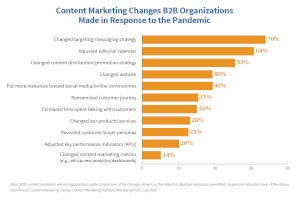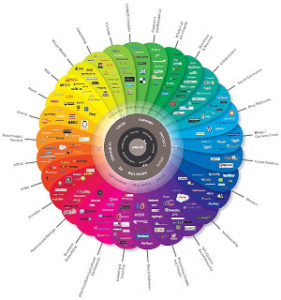Few could have foreseen the state of marketing during the year of COVID-19. But having endured mass pandemic and a record number of natural disasters, consumers have made notable lifestyle adjustments to which marketers are better equipped to track than at any other time in the history of economics.
As such, the state of business-to-business marketing in 2021 forces many large, small, and medium enterprises to digitally transform. At Sum Total Marketing, here are our reasons for why this is taking place.
What 2020 Has Taught Marketers
Doing business in person has been all but impossible in 2020. Video conferencing platforms, e-signature web services, and productivity software have scrambled to keep up with demand.

Business acquisition efforts have adjusted, as well. In many ways, account managers and marketing teams are more productive at home due to certain implied organizational changes, such as decentralized decision-making and somewhat flexible schedules.
However, many experts believe that the woes of 2020 have changed the marketing landscape more by way of accelerating disruptions already in effect before the outbreak of the coronavirus. Here are just a few.
Authenticity
High-profile, polished brand identities may not serve target audiences as they once did. Consumers are longing for greater authenticity. And to meet consumer demand for authentic media, B2B marketers must consider what their client’s clients expect from them.
Increased hardships for leaders and team members also forces professionals to use messaging styles that resemble loosening one’s tie or rolling up one’s sleeves. Businesses need practical solutions – ones that recognize the major shifts in consumer demand and can help the business meet those demands as efficiently as possible.
Smartphone Usage
Whether doing business from home or in a COVID-safe office, professionals are accomplishing more from the palms of their hands than ever before. Websites must be optimized for mobile, since nearly ¾ of web visitors do so from their smartphones.
Many brands are finding it advantageous to develop mobile apps or add client user accounts to productivity apps. These techniques increase engagement with clients and prospects for faster support and better collaboration.
Omnichannel
Omnichannel has become the buzz word for eCommerce over the last three years or so. But the principles overflow into every marketplace. Keeping up with the latest marketing and sales technology often means segmented data management and task redundancy.

Before managers insist that the problems above only affects internal operations, sales associates must demonstrate that poor efficiency ultimately forces clients to go through more hoops to sign a contract.
In the B2B sector, omnichannel means streamlining multiple sales, onboarding, and customer support processes. When one channel changes, it updates the others. This level of seamlessness ensures that clients feel cared for and receive prompt services.
State of B2B Marketing in 2021: 3 Trends to Watch
Based on major developments this past year, B2B marketers should begin planning now for these 2021 trends.
More Ways to Create and Consume Content
While mostly popular among DTC and B2C brands, social media arguably advanced three years worth of content option development over the last nine months. B2B organizations are able to take advantage of more live streaming options for free, as well as leverage short form video on two widely popular platforms, Instagram and TikTok.
Google is also adding more user-focused features on its search engine results pages (SERPs). Web developers and SEO specialists will need to optimize their pages for snippets and other SERP features that help them gain a competitive advantage in Google rankings.
Additional content strategy tactics, such as micro content, lifestyle images, and SMS two-way messaging are opening more options to marketers when tailoring their content to their target audience.
Evolution of User-generated Content
What began as watching reviews on Google or the Better Business Bureau has turned into a user-generated content (UGC) rich world of key opinion leaders, influencers, and brand ambassadors.
The principle behind its success is simple: positive UGC lends credibility to the organization it mentions. UGC is any third-party mention of your brand across digital platforms, including forums, social media, and online business directories.

B2B marketers can harness this UGC by publicizing branded tags and hashtags among members of their audience. They can also partner with influencers to stimulate online UGC among lookalike audiences.
The Internet of Things and Analytics
Of course, we’d be remiss if we failed to mention that the IoT continues to offer invaluable user and buyer information to businesses. There are increasingly more systems that can analyze user behavior on websites, setting preferences, and page clicks.
Transaction data also reveals critical information that can help B2B marketers build a more complete narrative of their ideal prospects. Often, the difficult part is not gathering the data as much as it is organizing and understanding that data.
Marketers will need to become familiar with basic analytics software or outsource analytics to an expert. Not only can the latest analytics information lower advertising and marketing costs, but it will also help decision-makers adjust price points and develop better products and services.
In Conclusion
As a quick recap, digital transformation is critical for organizations that want to stay relevant in 2021. All the latest B2B marketing developments demonstrate that the best ROI lies in understanding social platforms, customer online engagement, and web analytics.
What will always be true of marketing is that it is a trial-and-error business. But watching trends and knowing your customers will minimize waste in your marketing budget.

Perfectly constructed article.